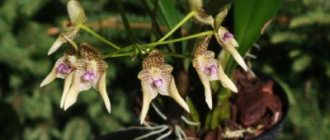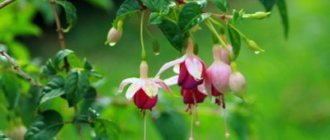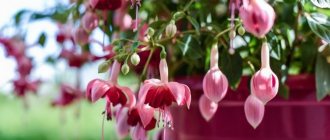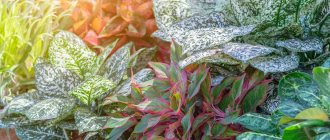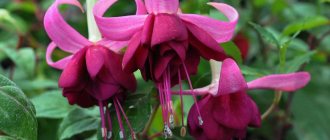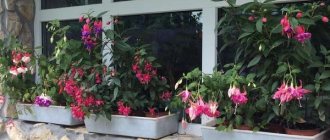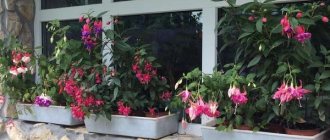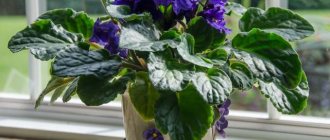Description of the plant and features of fuchsia
The first mention of fuchsias was recorded about 300 years ago, and since then, breeders have developed more than a thousand varieties of these beauties.
There are ampelous and bush varieties of fuchsias. Spectacular, graceful, fuchsia has become famous for its unique flowers, which cannot be confused with any other plant. Flowers are double, semi-double and simple. The group for home floriculture is varied in shades. There are white, lilac, pink, beige, violet. You can often observe combinations of 2-3 shades in the structure of one bud.
Fuchsia, a well-known houseplant, has acquired a “second wind” with the production of hybrids capable, firstly, of propagation by seeds, and, secondly, of blooming relatively soon, 4-5 months after sowing. Since several species are mixed in the “blood” of this hybrid, it is often called hybrid fuchsia (F. x hybrida). But not only the ability to bloom in the year of sowing allows us to classify fuchsia as an annual plant.
More importantly, it blooms all summer in open ground. At the same time, fuchsia remains a perennial; in winter it can be kept in a cool, bright room and cut out in spring
Fuchsias bloom from July until the first frost.
Indoor fuchsias (Fuchsia hybrids, Fuchsia x hybrida) are much more elegant than those that grow in natural conditions. In nature, they resemble small spreading trees or lush shrubs, strewn with clusters of fragrant flowers. Fuchsia appeared in Europe in the 17th century thanks to the explorer and botanist Leonard Fuchs. At first it was considered a great curiosity and was grown in the winter gardens of nobles.
Gradually, hybrid varieties were developed that were more adapted to northern latitudes. This is how bush, ampel and semi-ampel forms of fuchsias appeared. Today, it is very rare to find species of fuchsias in indoor culture; in the vast majority of indoor fuchsias, they are hybrids.
Fuchsias provide a considerable choice of possibilities for changing the form of cultivation. They are good both as hanging crops or graceful vines with shoots hanging down, and as graceful bushes, and as plants formed on a figured support. They can even be driven out in standard form, forming trees of amazing beauty.
Today, fuchsias are represented by spreading, ampelous and upright growing varieties with a height of 30 to 70 cm, with flowing, straight or creeping, partially woody shoots, up to 70 cm long. The shape of a fuchsia bush can be easily controlled by pinching. The leaves are large to medium-sized, ovate-lanceolate or oval with pointed tips and pronounced veins, most often with a serrated edge.
The most attractive thing about fuchsias is their flowers. They are considered exemplary graceful not only because they droop down and elegantly hang on their stalks. The flowers of this plant have been compared to dancers and their spectacular skirts. Some have completely different associations - with elegant lanterns. And the structure of the flower really has a lot in common with the outfits of ballerinas. In fuchsias, the flower consists of a calyx and a corolla. The elegant calyx resembles a simple flower with petal-shaped sepals, on which lies a bell-shaped corolla.
Small classic varieties with 4-5 corolla petals compete today with varieties with giant double flowers, the corolla of which offers you to admire the most bizarre curvatures and shapes. Narrow and long, short and wide, large, small, twisted, with ruffles - fuchsia corolla petals can be anything you want. But it’s also worth taking a closer look at the calyxes: in some fuchsias the sepals are straight and lanceolate, in others they are ovate and drooping down, in others they are raised up. And the stamens, which are always longer than the corolla, only emphasize the gracefulness of the plant.
The fuchsia color palette today can surprise even artists. The calyx and corolla almost always differ in color. A light cup and a dark corolla, or vice versa, contrasting tones or similar shades, completely different in color saturation, are mixed in limitless variations, and sometimes we are not even talking about two-color combinations: transitions, play, variegated spots significantly expand the idea of the palette. Fuchsia colors include white, cream, light green, blue, lilac, violet, red and pink.
Formation of standard trees
Fuchsia ampelous does not need pinching or pruning.
As for bush varieties, some of them have a neat crown, while others should be pruned periodically. Ballerina is one of the plants that is perfect for forming decorative standard trees. Both hanging (for example, Auntie Jinks) and bush (Annabel) fuchsias are very suitable for this purpose. In order to get a standard, you need to take a strong, well-rooted young fuchsia and tie it to a peg. After the plant reaches the desired height (you can make “trees” from 30 to 105 cm), it is pinched. As soon as the third pair of leaves appears and the fuchsia outgrows the peg, it needs to be cut off again. This is continued until the plant has formed a thick, lush crown. If you wish, you can plant two fuchsias in a pot at once and intertwine their stems. As it grows, weaving must be continued. In this case, you will get a richer crown.
From the history
The “father” of fuchsia is considered to be the French monk and botanist Charles Plumier, who discovered it on the island of Haiti in 1696–1697. In Paris in 1703, his work on plants found in America was published. It was there that the name fuchsia was first heard, which he gave in honor of the famous German doctor and botanist Leonhart Fuchs. The species that Plumier discovered was fuchsia trifolia. Although the plant was already mentioned in an English botanical journal in 1725 under the name fuchsia, the British do not agree with the French authorship and believe that it was brought to them by their sailors.
From the end of the 18th century, during the “feverish gathering of plants”, new species of fuchsias began to arrive in England at Kew Botanic Gardens. Soon, breeding work began in nurseries, for which fuchsias turned out to be a very grateful object. Already from 1835 to 1850, numerous hybrids and varieties were created in England, which were grown in houses and open ground, where some of them overwintered.
In other European countries in the 19th century, fuchsia also found its fans. In Germany, the emphasis was placed on crossing with fuchsia trifolia. And the famous French breeder Lemoine developed many varieties with large double flowers. After 1930, new fuchsias began to be created in the Botanical Garden of the University of California, USA. Now breeding is also carried out in the Netherlands, Australia and New Zealand.
It is believed that over more than 200 years of selection, about 15,000 (!) varieties and hybrids of fuchsias have been obtained. Currently, however, about 5,000 are grown. In many countries there are societies of fuchsia lovers, uniting numerous fans of this wonderful plant.
Some fuchsias have flowers that point upward.
Magellan (Fuchsia magellanica)
Tall evergreen bush, reaching three meters in height. The purple leaves of the plant, up to 4 cm in size, have down along the veins. This fuchsia blooms all spring and until October. Flowers can be single or collected in inflorescences of 4 pieces.
Magellan fuchsia tolerates low temperatures. You can leave it to winter on a glazed balcony, having previously cut it to a height of 10 - 15 cm. and covering, for example, with fallen leaves. Usually the plant is brought indoors for the winter, preferably in the coolest place. Watering fuchsia during the dormant period is necessary, but rare.
This type of fuchsia is used to decorate arches, shop windows, and glass on the veranda.
Fuchsia Unusual
Thank you! The flowers arrived alive, not withered, some already with buds. PS I am writing a review after some time. The flowers are fresh, but none of them correspond to what was ordered. In addition, they sent 4 pieces. two identical fuchsias. Why do I need it? You order what you need, and what you get is: Oh, God, that’s not good for us. Just a devil-may-care attitude.
Of the three fuchsias, two look quite good, but the third sprout was all mixed with soil and broken, and is unlikely to come off. The pelargonium sprout is also not very good, most of the leaves are broken off, the lower ones are moldy, but there are a couple of new intact leaves, so there is hope. Not a single sprout is labeled; it is impossible to understand which variety of fuchsia sits where. I don’t even know whether to recommend the purchase or not. I'll add it in a couple of days. I transplanted them all and treated them with epin. One fuchsia sprout, as expected, died, broken. The pelargonium also died, it was overwatered and rotten. The price of dead plants is 570 rubles. It would be quite possible to purchase a healthy, flowering plant at the market. Also, don’t get upset looking at this hopelessness. So I don't recommend it.
The fuchsias arrived very weak. Thin, simply thread-like (I am not exaggerating) long branches up to 10 - 12 cm. One fuchsia has three branches so thin and long that they simply almost completely broke under their weight, almost at the base. Of course I spray it with epin, but I’m not sure it will survive. And putting such thin branches in water for root formation is unlikely to do any good. But the price is 280 rubles. I’ll add. No matter how hard I tried to preserve the broken fuchsia, nothing came of it. No epin helped. The other three are slowly coming to their senses. But you have to take great care of them.
The flowers arrived beautiful. Pelargonium grows well, fuchsia, after I unpacked it, quickly began to fade. But I replanted it, put a bag on top, and it began to grow. I hope for the best and that the flowering will be as in the picture.
The goods were delivered on time, but one of the four sprouts arrived with only one leaf with a dried out top, the next day this leaf also fell off. So most likely he won't survive. The other three are very weak, I don’t know if they will survive.
Distribution is fast, but packaging is a nightmare! Wrap two tiny stems in cloth, then in cardboard and put in a bag. They gave it to me like a regular package. There was no signature, which is fragile. This is not the first time I order flowers, but this is the first packaging. As a result, one flower was broken.
Armeria in landscape design
This flower is universal in the garden. Looks good with other flowers, but can grow independently as separate bushes.
Armeria in landscape design is used in rock gardens (gardens using stone elements), when laying an alpine slide, between slabs of garden paths, and as flower borders.
These flowers will look very advantageous and contrast against the background of bright greenery or tall plants. They also look good with other types of creeping flowers.
This unpretentious ornamental plant will be a wonderful solution for any garden. Easy care makes it convenient for propagation, including for novice gardeners.
Fuchsia propagation
If you want this perennial to produce many flowers every season, then you need to provide it with proper care. If such a need arises, planting material for propagation can also be obtained from it. There are many possibilities for this, since young plants can be obtained both from seeds and from cuttings and leaves.
Propagation by seeds
If you decide to get new fuchsia seedlings from seeds at home, keep in mind that this process will require a lot of time and effort. First of all, you need to stock up on quality seeds. To do this, you need to constantly monitor the condition of the mother plant, preventing its flower from self-pollinating. This can be done by carrying out the following activities:
- removing anthers from a recently opened flower;
- transfer of pollen from the paternal plant to the stigma;
- protecting flowers after pollination by covering them with a fabric or paper bag.
After a couple of weeks, the fruit reaches the maturity stage. After opening it, take out the seeds and let them dry for several days. For planting, use shallow containers filled with moist substrate. Seeds should be placed on the surface of the soil.
After sowing, the bowls with seeds must be transferred to a greenhouse, where optimal temperature and good lighting must be created. After 10-15 days, seed germination occurs. After another 1.5 months, the time comes to pick the seedlings. Subsequently, the young seedlings are hardened, for which they need to be taken out into fresh air for a while. The first time, hardening should be short - no more than 15 minutes, but later the residence time of the seedlings is increased. After another two months, the seedlings are transplanted into separate pots.
How to protect yourself from diseases in your apartment in winter?
If the rules for creating favorable wintering conditions are violated, the plant is often susceptible to a fungal disease called rust.
It occurs if the room temperature is too high and light is low, as well as due to excessive watering. To prevent the pathogenic fungus from touching the fuchsia, it should be treated with a 1% solution of Bordeaux mixture. This procedure will protect the flower from the appearance of brown and brown spots on the leaves, which destroy the plant. If you detect the fungus at first, you can save the fuchsia with a disinfectant mixture that contains water, green soap and copper sulfate.
In winter, the ballerina is susceptible to gray rot , the appearance of which is provoked by high humidity in the room. The disease is easy to identify by the affected areas: they are soft and watery, and there is a white coating on the surface of the leaves. The plant is treated with special preparations and mandatory changes in the microclimate in order to prevent re-infection of the plant.
Conditions for growing ornamental shrubs
In order for an ornamental shrub to feel good, you should know and follow certain rules for each variety.
Bright red and Bolivian fuchsia
Pots with indoor flowers should be placed on the east or north side. Even here, plants need to be protected from direct sunlight. During the dark period, the bushes need illumination from a fluorescent lamp or phytolamp.
Important! The best temperature regime is 19-21°C during the warm period, and in winter - no higher than 18°C. If this is not followed, the Japanese lantern will slow down its development and the flowers will begin to fall off
When the flowers appear, the pot with the plant should not be touched. With any movement, the buds fall off.
Watering is carried out regularly when the top layer of soil dries out. The water that has flowed into the pan is drained.
Fertilizing with complex fertilizer is needed once every 2 weeks in all seasons except winter.
To increase the humidity of the surrounding air, place containers with clean water next to the pot or spray the fuchsias. Otherwise, dry air will cause yellowing and wilting of leaves and flowers.
Fuchsia Brilliant
Loves semi-shaded places. From the beginning of the warm season until the onset of autumn, it requires abundant watering with soft water, standing for several days.
Three-leaved fuchsia
This hardy plant is grown in open ground. For planting, choose a slightly shaded place with fertile and neutral soil. Regular watering ensures that the soil around the plant is always moist. Fertilizing is done weekly with liquid fertilizer.
Magellan fuchsia
Feels great in open ground under snow cover. The hardy plant can overwinter on a glassed-in loggia.
Recumbent fuchsia
The shrub does not tolerate the scorching sun at all. It should be planted in a wire basket filled with peat moss with the addition of perlite and vermiculite.
Note! The mixture is first thoroughly soaked in water, only then placed in the basket. If you add dry ingredients, the mixture cannot be soaked by watering
At the beginning of autumn, the plant can be moved from the site to a room with soft light and a temperature not higher than 18°C. Watering should be done moderately. With the onset of spring, fuchsia is moved to a warmer place and periodically fed. The basket with the plant is taken outside only after stable heat has been established.
Features of winter care
Only by following certain rules can you preserve healthy fuchsias until spring. Caring for them in cold weather is not difficult. Ballerinas are not fed and watered quite rarely, however, in order for the plant to bloom profusely the next year and remain completely healthy, it should be placed in a dark, cool place with a temperature of +8 ° C with moderately dry air. It is highly not recommended to weaken fuchsia by autumn pruning. This operation is performed in the spring. If the branches are very weak, you should pinch off a piece of bark from the trunk and look at the wood. Green color indicates that the shoot can still grow. If the wood has a brown tint, it means the branch has died and needs to be removed.
Fuchsia ampelous - planting and care outdoors
Evenly falling shoots of the plant, at the peak of flowering, turn into a mini-floral waterfall. But for this you need to create suitable conditions for them.
Landing
The flower is grown using seeds and rooting cuttings.
The first method is usually used by breeders to obtain new varieties. It is painstaking and time-consuming; moreover, it does not guarantee a variety with maternal characteristics.
Rooted fuchsia cuttings
For amateur gardeners, it is preferable to propagate the variety you like by cuttings. It is enough to place the parts of the shoots remaining after pinching (15-20 cm) in water for 10-14 days. After the cutting takes root, it can be planted in a permanent place. To quickly get a dense bush, you can plant several cuttings in a pot. For good root formation, moderate temperatures of up to 20-23 ° C and regular watering are needed.
Seedlings received by mail or purchased in a store are transplanted using the transfer method from a container into a container, with a mandatory layer of drainage, and topped with soil.
For fuchsia to feel good you need:
- place it in an area protected from drafts and wind;
- the place for growing must be selected, avoiding the south side;
- provide the plant with a neutral soil pH;
- Use soil for planting that is permeable and light;
- Feed regularly, every 2-3 weeks - this will make flowering longer and more generous.
Important! Fuchsia does not like heat and does not tolerate direct sunlight. In summer, the bush needs frequent watering; it is also recommended to moisten the above-ground part with a sprayer.
You need to focus on the drying soil around the roots of the plant; excess moisture can harm them
In summer, the bush needs frequent watering; it is also recommended to moisten the above-ground part with a sprayer. You need to focus on the drying soil around the roots of the plant; excess moisture can harm them.
Basic rules for caring for fuchsia during the growing season
The main measures for caring for fuchsia, after its acquisition, are considered:
- correct choice of location;
- compliance with temperature and humidity conditions;
- feeding
In the life of fuchsia, two periods :
- active growth: from spring to autumn;
- relative rest: winter.
Let's consider the rules for caring for a fuchsia flower during the period of active growth . At this time, the plant should be placed on a well-lit windowsill of an eastern or western window, but not in direct sunlight. It is better not to put fuchsia on southern windows, because... she is too likely to get sunburned.
If there is no bright place in the house for fuchsia, then it should be provided with additional
artificial lighting , using, for example, fluorescent lamps.
Otherwise, fuchsia blooms may not be seen. This also applies when installing a flower on a northern windowsill with insufficient light.
The plant loves clean, often ventilated air . The presence of drafts is unacceptable. Rearrangements from place to place and rotations around its axis are not desirable for fuchsia. The air temperature during this period should be approximately +20+22 degrees.
higher ambient temperatures You can place fuchsia on a balcony, loggia, or open terrace in the summer. To prevent the sensitive root system of the plant from overheating in the heat, you need to transplant it into a wide ceramic pot.
Watering fuchsia during the growing season should be moderate: the soil should not become moldy or dry out. Water for irrigation should be used that is settled, soft, and at room temperature. In the hot season, the plant needs to create an additional humid microclimate.
Early in the morning or in the evening it is good to spray fuchsia with cool water. You can place a beautiful container with water and pebbles next to the flower, which will help create the desired microclimate around the flower.
The plant needs weekly feeding with fertilizers throughout the active period. After flowering has stopped, you can take a short break from using fertilizers. In the fall, from about September-October, fertilizing the flower is gradually stopped. As fertilizers, special fertilizers for house flowers are used with a high content of phosphorus and potassium, which are so necessary for the normal functioning of the flower.
With proper care, fuchsia will delight everyone with its long and lush flowering, from May to the end of November. A prerequisite for long-term flowering of a plant is the constant removal of faded flowers .
Throughout the growing season, the plant should be constantly pinched to form the desired shape. You need to be prepared for the fact that each pinching delays flowering for almost 2 months.
At home, fuchsia should be replanted annually . It is better to carry it out in March. The scheme for this is simple: first, drainage is placed in the pot, on which the prepared earthen mixture is placed, the plant with the earthen lump is carefully transferred and sprinkled with earth.
Reproduction and transplantation
If you plan to propagate a plant by seeds, you should first protect the unopened bud from self-pollination and pollination by insects.
Specks of dust from the bud must be removed in advance, and the bud itself must be covered with a cover of paper or fabric. When the flower is ripe, the seeds must be carefully collected and sown in accordance with the procedure indicated in the previous paragraph.
The vegetative propagation method can be used at any time of the year, but experienced breeders recommend doing it in the spring. Observe the following rules:
- for propagation you need to choose a young cutting from 10 to 20 cm long;
- remove the leaves at the bottom of the cuttings, cut the rest by half;
- place the cuttings in filtered water;
- Cover the top of the cutting with film or a bag, you can use a bottle.
You can expect the first roots to appear in 4-5 days, but in some cases you have to wait about 2 weeks. When they appear, you need to immediately plant the cuttings in the substrate.
Read more about how to propagate fuchsia from leaves here, and from this article you will learn how to properly transplant fuchsia and get abundant flowering.
Watch a video about propagating fuchsia by cuttings:
Fuchsia is a beautiful indoor plant with lush flowers. Although it is quite unpretentious, to successfully grow it you need to know the rules of care both at home and in the garden. Also read our materials on how and when to prune a flower.
Why does the bush stop blooming?
If after planting the young fuchsia does not begin to bloom, they look for errors in care. They are especially often done by novice gardeners in the autumn-winter period.
It is important to reduce the temperature to +8-10°C during the dormant period so that the crop does not begin active growth too early. To stimulate growth when temperatures rise in the spring, daylight hours begin to be artificially increased.
Untimely pruning can affect the formation of buds. Diseased and weak shoots need to be removed regularly.
On a note!
Pruning is carried out in the spring, when the plant is actively growing but not yet blooming. The bushes are pruned extensively in the fall, after flowering has ended. In winter, each shoot is cut to 1/3 of its length.
If fuchsia is warm all year round, then pruning is performed only once (late February - early March). The form given to culture depends solely on the desire and imagination of a person.
How to pinch correctly?
- The pinching procedure is carried out to form a thick, compact and beautifully formed bush. Shoots ensure the formation of new buds, so we must strive to increase them.
- The crown is cut off from cuttings that have taken root. There should be 6 leaves left, new shoots are forming. Further, they are also pinched.
- This method creates a bush and ampelous appearance of flowers.
- If there are several cuttings in one flowerpot and simultaneous pinching will lead to the formation of a powerful bush and simultaneous flowering. This happens after 75 days.
- The next pinching occurs in February, before the upcoming flowering.
To get a standard tree, you need to maintain the cutting height to 100 cm or lower. For this, an erect stem that is quite strong is used.
- Then only the top of the head is trimmed.
- Since the shoot is very thin and fragile, it should be supported. You can use a bamboo stick. Tie it to the stem with a soft cloth.
- The appearance of 6–7 shoots will be a signal for the formation of a trunk crown. After the first or second pairs of leaves appear on the shoot, they are pruned.
- Leaving the leaves behind will help the plant establish itself. Therefore, you cannot remove them all at once; this must be done gradually, waiting until the crown begins to form.
- Small-flowered plants are excellent for forming a standard tree.
The ampel form is carried out in various ways:
- A cap is formed by cutting off the shoots after the second node. The next shoots grow a little longer.
- Another option is to trim through two nodes several times, and only then leave long shoots.
There is no need to be afraid of pruning, just remember that pinching delays flowering.
Sofia Fedorova
This creation by sculptor Natalia Danko, which exists in several versions of painting, was a constant hit at international porcelain exhibitions in the 1920s and was produced intermittently until the early 1950s.
Sofia Fedorova (1879−1963), who inspired the appearance of this work, went down in the history of ballet as Fedorova the Second, because when she was accepted into the Bolshoi Theater troupe, her namesake was already in the corps de ballet. The technique of this gypsy by blood was not without flaws, but thanks to her stormy temperament and the art of transformation, her characteristic dance brought the audience into ecstasy.
Dancing Giselle in April 1913, Fedorova frightened the audience with an overly naturalistic depiction of her heroine's madness and death. The ballerina was so deeply immersed in the role that she began to be haunted by severe neurasthenic attacks, which later developed into an illness. Soon she had to spend more and more time in psychiatric clinics and less and less time on stage. When Fedorova became better, such iconic figures as Anna Pavlova and Sergei Diaghilev wanted to work with her. However, the disease took its toll.
Varietal types of fuchsias (description)
In floriculture, there are about one hundred species of fuchsias. In cultural gardening, varieties and hybrids obtained from them are used. Today there are about twenty thousand varieties and hybrids of this beautiful plant. Their number continues to increase.
- Fuchsia Basseveldse Ezels with dense double inflorescences, grows in the form of a bush, has rounded buds of inflorescences with a white-pink combination of sepals on the inside with a cherry tint coating. The skirt of the flower is bright red. Fuchsia flowers Basseveldse Ezels: photo
- Fuchsia Bicentennial. A unique varietal hanging plant with large elongated salmon-colored buds. The flower is framed by a red terry skirt with peach-colored strokes. The blossoming flower changes color, becoming orange. Fuchsia Bicentennial flowers: photo
- Bolivian Fuchsia. A tall bush variety about one meter high with very large flowers collected in hanging clusters. The plant is designed for growing in a warm room and does not respond well to low temperatures. The flowering period occurs in March-April. Bolivian fuchsia flowers: photo
- Fuchsia Lenny Erwin. The plant has an ampelous shape, blooms with large double flowers with white sepals with green tips. The fluffy skirt of the flower is lilac in color. The form of the variety is ampelous. Fuchsia flowers Lenny Erwin: photo
Problems
Growing fuchsia is not accompanied by any serious complications. She practically does not get sick, and insect pests rarely contact her.
Usually all the plant's troubles begin as a result of improper care. For example, excess air humidity can lead to the formation of dewdrops on the leaves, and repeated excessive watering can lead to chlorosis.
Important! Foliage color is an indicator of the condition of the plant. Rich green - fuchsia is healthy; the appearance of yellowness indicates a lack of nutrition or flaws in watering.
Beginning gardeners are sometimes faced with the question of what to do if fuchsia does not bloom. There may be several reasons for this phenomenon: keeping the flower in a warm room in winter, lack of light, fertilizer, excessively frequent or, conversely, rare watering. An analysis of the care provided will answer this question, and correcting the situation will help the plant recover and enjoy flowering next season.
An undemanding culture with ballerina flowers is very popular among flower growers in many countries. This is not surprising, since the effort put into growing fuchsia is far less than the joy and tenderness it gives, and completing the listed stages of caring activities will allow you to grow a luxurious fuchsia, such as in the photo presented in the article.
Description, main varieties and types
Depending on the characteristics, fuchsia can take the form of an ampelous plant, a shrub or a low-growing tree. During development, it forms flexible shoots that provide a cascading crown. The leaves are small in size and reach a length of 5 cm, the characteristic color is bright green, oval in shape, with a pointed end.
Fuchsia can have flowers of different shades, ranging from white and pink to blue and purple. Among them there are some that are quite amazing in their shape: in the form of bells or dancing ballerinas. This pronounced decorative effect is explained by the unusual structure of the flower. The petals are formed from a tubular corolla and, at the stage of full opening, form fluffy skirts, reminiscent of a group of dancers. The long stamens complementing them are very similar to slender legs dressed in pointe shoes.
Popular varieties
The wide species diversity of this plant did not go unnoticed by breeders, and subsequently they served as the basis for the development of new varieties and hybrids. Mainly hybrid forms are intended for home cultivation. Depending on the growth, the following types of fuchsias are distinguished:
- bush. They have smooth shoots that face upward;
- ampelous. They form flexible stems that are cascading;
- hanging-bush. To give them a characteristic shape, they need support so that long stems can be tied to it.
Within the bush fuchsias, the following varieties can be distinguished, which are most often used for growing in floor containers:
- Armbrough Campbell. This variety is distinguished by its unpretentiousness and the minimum time required for rooting. Flowering occurs in winter: at this time of year, large double flowers are formed, decorated with narrow leaves and soft pink petals;
- Alisson Bell. The decorative properties of this variety are associated with its semi-double violet-reddish flowers;
- Anabelle. During flowering, large double white flowers are formed. Within this variety, hanging plants are available;
- Henriette Ernst. The originality of this variety is given by the scarlet sepals, which are decorated with a light lilac skirt;
- Waist. This fuchsia variety produces bright orange flowers.
Many gardeners often choose hanging varieties of fuchsia for growing at home.
The latter attract attention with their curling shoots hanging from hanging baskets and flower pots. The most popular of them are the following:
- Hollies Beauty. During flowering, double white-pink flowers are formed;
- Prince of Peace. This variety is decorated with flowers formed by white sepals and a red skirt;
- Blue Angel. The originality of this variety is given by flowers having a lilac-violet color, which is effectively complemented by white sepals;
- Imperial Crown. It produces scarlet-colored flowers with an elongated shape, which are presented in the form of brushes.
Eschszolzia - species
This amazingly beautiful plant came to Europe from North America. There, in 1816, naturalist Johann Friedrich von Eschsholtz first collected California poppy seeds. In his honor, the plant received its second name - eschscholzia. In our homeland, even in those days, there were about 12 species of Eschscholzia; in our country, only three became widespread - Californian, Soddy and Lobba Eschscholzia. But since science does not stand still, today Eschscholzia in the garden can be full of unconventional shades and show off with double and regular petals.
Eschscholzia terry
Breeders have developed many hybrids of this flower. But among the numerous varieties of Eschscholzia, flower growers especially loved the double species. They seduce with large silky petals of various colors - white, cream, carmine, pink, have petals that are corrugated or smooth along the outer edge, and depending on the variety - have different flowering periods, shapes and sizes. Like its fellow terry eschscholzia, growing from seeds and caring for it does not require much time and effort. The plant is not whimsical, tolerates drought well, and reproduces by self-sowing.
Eschsolzia Ballerina
One of the types of Californian Eschsolzia - Eschsolzia Ballerina will decorate flower beds, alpine slides and lawns. The flowers of this variety are distinguished by a delicate salmon color, large diameter, semi-double petals, corrugated along the edge. Eschscholzia Ballerina bushes are very beautiful, growing up to 40 cm in length. Ballerina seeds are often mixed with other hybrids - the result is bright, truly summer plantings.
Eschsolzia Orange King
A royal flower with an ordinary disposition, unpretentious to living conditions, cold-resistant, tolerates frosts down to -5°C, and its flowering period is 120-150 days. This variety of Eschscholzia has an orange color - bright and rich, flowers reach 5-6 cm in diameter, double and simple petals in quantities of 4 to 15 pieces, strongly corrugated, without a characteristic aroma. The orange king combines well with other colors, creating magnificent compositions in flower beds, balconies, and flower beds.
Eschsolzia Mirage
The perennial Eschscholzia Mirage will be a real decoration of a flowerbed or rocky hill. This variety comes in a rich range of colors. Alternately changing each other, white, pink, lilac, yellow inflorescences delight the eye from June to October. The flowers reach a diameter of 5 cm and can have either a smooth or silky texture. Mirage loves light and well-drained soil and does not require additional frequent watering.
Eschscholzia Apple blossom
A very beautiful delicate flower - eschscholzia apple tree flower. This variety is considered the most popular among flower growers and summer residents. Apple blossoms resemble the flowers of a fruit-bearing tree, only they are larger in size; when opened, the diameter of the flower reaches 5 cm. The inflorescences have a soft pink color, a densely double texture and petals that are corrugated at the edges. This type of Eschscholzia is also easy to care for.
Eschsolzia Thai silk
When answering the question of what Escholzia Thai silk looks like, it is difficult to give an unambiguous description. This variety is replete with rich warm shades, forms a lush bush about 50 cm high, and boasts beautiful openwork foliage that shimmers in the sun. Thai silk flowers reach a diameter of 7 cm, begin to bloom in early summer, and right up until mid-autumn they delight the eye with their abundant flowering.
Eschscholzia California poppy
Unlike its artificially bred counterparts, Californian eschscholzia is considered a perennial plant. Once you sow it in a flowerbed, you can safely expect that next year shoots will begin to appear with the first warmth. Externally, the inflorescences resemble wild poppies, with the only difference being that their colors can vary from white to deep red. Eschscholzia flowers - growing them in summer cottages and garden plots is not a painstaking task, since the plant is not picky and does not require frequent watering and regular feeding.
What is it: general description
Fuchsia is an ornamental plant from the fireweed family. These are small trees or shrubs with flexible shoots of a reddish color, medium-sized lacent or ovate leaves located opposite, and numerous flowers of various shapes and colors.
This ornamental crop has a bushy or creeping appearance. A distinctive feature of fuchsia is the flower. It consists of two parts - a corolla-shaped calyx and a bell-shaped or tubular corolla (skirt) of a different color. All parts of the flower are brightly colored.
Fuchsia varieties that have 4-5 petals and a rather small flower are called non-double. Large fuchsias, the corolla of which consists of many petals, are considered terry.
Attention: This culture belongs to the group of unpretentious plants. Fuchsia is easy to care for and grow and perfectly decorates the interior.
Origin: Brief History
Fuchsia is named after the famous German scientist, botanist and physician Leonard Fuchs. This plant was discovered by Catholic priest Charles Plumier at the end of the 17th century. He traveled across the South American continent in search of medicinal plants and found this plant there.
In 1703, in the book Nova Planetarium Americanum Genera, an article about the discovery of a new species was first published. According to the generally accepted version, this date became the “birthday” of fuchsia.
Modern varieties
In addition to the fuchsia varieties presented above, the gardener can choose a suitable one from the more modern ones, which have not yet become widespread among gardeners.
- The fuchsia corollas, called Natasha Sinton, have an unusual pink color that represents purity.
- The fuchsia shades of Bella Rosella can amaze even an experienced gardener with their richness. This is the natural color of the variety, although many believe that corollas of this color cannot exist in nature.
- Fuchsia Marinka is not easy to distinguish from the previous one, however, these plants have denser petals and their number is several times greater.
- The description of the corollas of the fuchsia variety Izabela Cieszynska is unusual: it seems that inside the outer layer of the petals there are several more flowers, they can be so lush.
- Fuchsia called Grandi Sea is frost-resistant. It is thanks to this that the plant does not require special care during the cold season.
- The corollas of the fuchsia Bicentennial have a rare color: they are of a peach hue, turning into a rich orange.
Thanks to the actions of breeders, any gardener can choose a representative of the fuchsia genus to their liking. All varieties differ in the shape of the buds, color, and height of the bush. This will become the main selection criteria!
Superstition about a flower
Fuchsia is a common flower. Once in the house, it becomes its decoration. She is credited with magical properties. The plant is not too picky, but requires special care. Loves moist soil. Watering should be organized so that the soil is always slightly moist. The main thing is not to over-moisten. In this case, negative consequences are possible, including the death of the plant.
Overdrying the soil also has negative consequences. In this case, the leaves fall off and the formation of flower stalks stops. There are some tips for proper plant care:
- if the leaves begin to become covered with brownish-yellow spots, then watering should be interrupted and wait until the soil dries;
- if the plant has withered and the soil is wet, then it needs to be moved to a sunnier place;
- the flower really likes washing and spray treatment.
It is useful to have this kind of plant for creative people. It gives them inspiration and fills them with energy. It grows and emits special energy.
In a house where representatives of several generations live, mutual understanding and prosperity will reign. The love that a person gives to this flower multiplies and returns to him in the form of an increase in inner beauty and charm.
For your information! In addition to all the positive qualities, fuchsia is considered a flower whose owner in most cases is a single woman. Many gardeners call fuchsia a widow's flower.
Basic rules for caring for fuchsia during the dormant period
In winter , when caring for fuchsia, you need to take into account that the flower is in a state of sleep and dormancy.
During this period, it is important to create optimal conditions of detention. temperature during this period should not rise above 10 degrees. For this purpose, when growing a plant in a city, you can use an insulated loggia.
Good lighting and a constant flow of fresh air must be provided in sufficient quantities during the winter period. In exceptional cases, fuchsia can be left for a period of rest without light. Watering the plant in winter is significantly reduced - up to 1-2 times a month. But the soil is not allowed to dry out. During the dormant period, fuchsia should not be fertilized. It is important to know that if the specified plant care is not followed in winter, fuchsia will not bloom during the growing season.
Formation rules
Formation begins at the earliest stages of development - after rooting and the beginning of growth of the cuttings. You can use one of the most common forming methods.
- Upright bush. Bush varieties of fuchsia are suitable. Formation involves pinching the shoots after two pairs of leaves appear. All subsequent side shoots are pinched using the same pattern. If the distance between the nodes is small, pinching through 3 nodes is allowed.
- Standard tree. Bush varieties are used to form a trunk. A support is stuck into the ground next to the cutting and tied with soft material. The young trunk does not need a period of rest. Side shoots of the first order are not removed, but their growth is limited by pinching after 2-3 pairs of leaves. As they grow, they are transplanted into larger containers. At a height of 0.5-1 meters, pinch the top. The crown is formed according to the principle of a bush. Regular pinching makes the crown thick and even. To grow a standard tree, it is not recommended to choose varieties with large flowers.
- Ampel form. Only one node is left on the first shoots. Side shoots are pinched after 2 pairs of leaves. Subsequent growth is not limited.
Fuchsia is easy to shape and quickly recovers after pruning. The only negative is the delay in flowering.
Advice! It is useful to feed young plants with organic matter and fertilizers with a high nitrogen content. Adults fertilize with potassium and phosphorus for lush flowering.
Diseases
These flowers get sick relatively rarely. But gross mistakes made during care can cause illness. The florist needs to know about this.
There are two categories of diseases:
- diseases caused by improper care;
- cases of flower damage by fungi and pests.
Improper overwatering leads to root rot. The solution to the problem is to wash the roots with warm water and cut off the rotten part. Then the fuchsia is placed in a bowl with clean water, and after new roots appear, it is planted in a pot with new soil.
Sometimes growth slows down due to the fact that the plant needs to be transplanted into a larger container.
Paying attention to the leaves, you can judge the lack of essential nutrients. Small brown spots appeared on the leaves - a lack of molybdenum. Manganese deficiency can be indicated by yellow veins on the leaves. Their pallor and lethargy will indicate a lack of nitrogen.
Attention! In the summer, the cause of pathogenic microbes getting on flowers can be insects flying into open windows. Whitefly is a small, almost invisible butterfly that lays eggs on the underside of leaves. Sticky sugary droplets appear on them
The hatched butterflies begin to suck the juice from the leaves. The result is their yellowing and falling off.
Sticky sugary droplets appear on them. The hatched butterflies begin to suck the juice from the leaves. The result is their yellowing and falling off.
Whitefly is a small, almost invisible butterfly that lays eggs on the underside of leaves. Sticky sugary droplets appear on them. The hatched butterflies begin to suck the juice from the leaves. The result is their yellowing and falling off.
Immediately after identifying the first signs of the appearance of whiteflies, you should prepare warm water with laundry soap and wash the stems and lower parts of the leaves. The root system needs to be protected from soap. This can be achieved using polyethylene film. If this method does not help, then you need to use Fitoverm, Aktara, Actellik, strictly following the instructions.
The presence of warm and dry air in the room contributes to the appearance of spider mites. The appearance of a gray coating on the leaves, thin cobwebs and a large number of black dots are the main symptoms of infection. Bath procedures do not always help get rid of insects. They resort to treatment with Fitoverm, Fufanon.
From all that has been said, the conclusion is: fuchsia is a very beautiful and useful plant in a house with an interesting history. Even a novice gardener can cope with its cultivation.
Rose Ballerina: reviews from those who grow
Elena, 45 years old, Kazan: 4 years ago I was given 7 cuttings of the Ballerina rose. I planted one cutting separately in an empty space in light partial shade, and planted the rest as a border. A year later, overgrown bushes began to form: the free-standing bushes were spherical in shape, and those growing in the border were barrel-shaped. I constantly increase the border by propagating this rose by cuttings. I grow them in partial shade - this way the flowers fade less and the hedge looks more beautiful. I rarely water during the season, since this perennial shrub is undemanding to soil moisture. During rainy seasons, this rose does not need to be watered at all. I don’t do hilling and rarely feed them.
Varieties of roses:
Rose Midsummer variety AQUA Rose Stromboli
Zhenya, 38 years old, Belgorod region: I don’t really like musky rose varieties, but the Ballerina rose attracted me with its abundant flowering throughout the summer season. Its disadvantage is the rapid fading of the buds in the sun, so you have to grow Ballerina in a shaded area to preserve the colors of the flowers.
Schefflera price
Small plants are offered for 400-500 rubles. But these are single bushes. What you should be afraid of is not that they will fall. Sheflera does not tolerate pruning well. Instead of forming a beautiful crown, the result is an unsightly plant.
Therefore, if you want a bushy specimen, purchase several flowers in one pot. There are already ready-made compositions, the trunks of which are woven into braids and voluminous “lattices”. For a meter-long flower you will have to pay 8,000-9,000 rubles.
But, there are also pots with, so to speak, preparations for the composition. Several Scheffleras grow separately. In this case, flower growers pay only for the number of plants. A flowerpot with three sprouts can be purchased for 1,300-3,000 rubles.
Fighting possible diseases and pests of Armeria
To the delight of flower growers, this plant practically does not suffer from diseases and is not affected by pests. However, if the soil acidity is insufficient, then aphid “attacks” may occur or the armeria will develop spotting. At the first problem, the leaves and stems become as if dried out and then you will have to remove the affected parts of the flower. But to prevent this from happening, it is recommended to carry out treatment with insecticidal preparations as a preventive measure, among which Intavir, Karbofos, Aktara or Actellik are popular.
If the soil is in a flooded state for a long time, which happens in early spring due to melting snow or an incorrectly chosen place for planting Armeria, then rotting of the root system develops and spots of brown color form on the leaves. When the problem is noticed in time, then by spraying with fungicides you can still save the bushes, but if the damage is severe, you need to burn the diseased plants.
